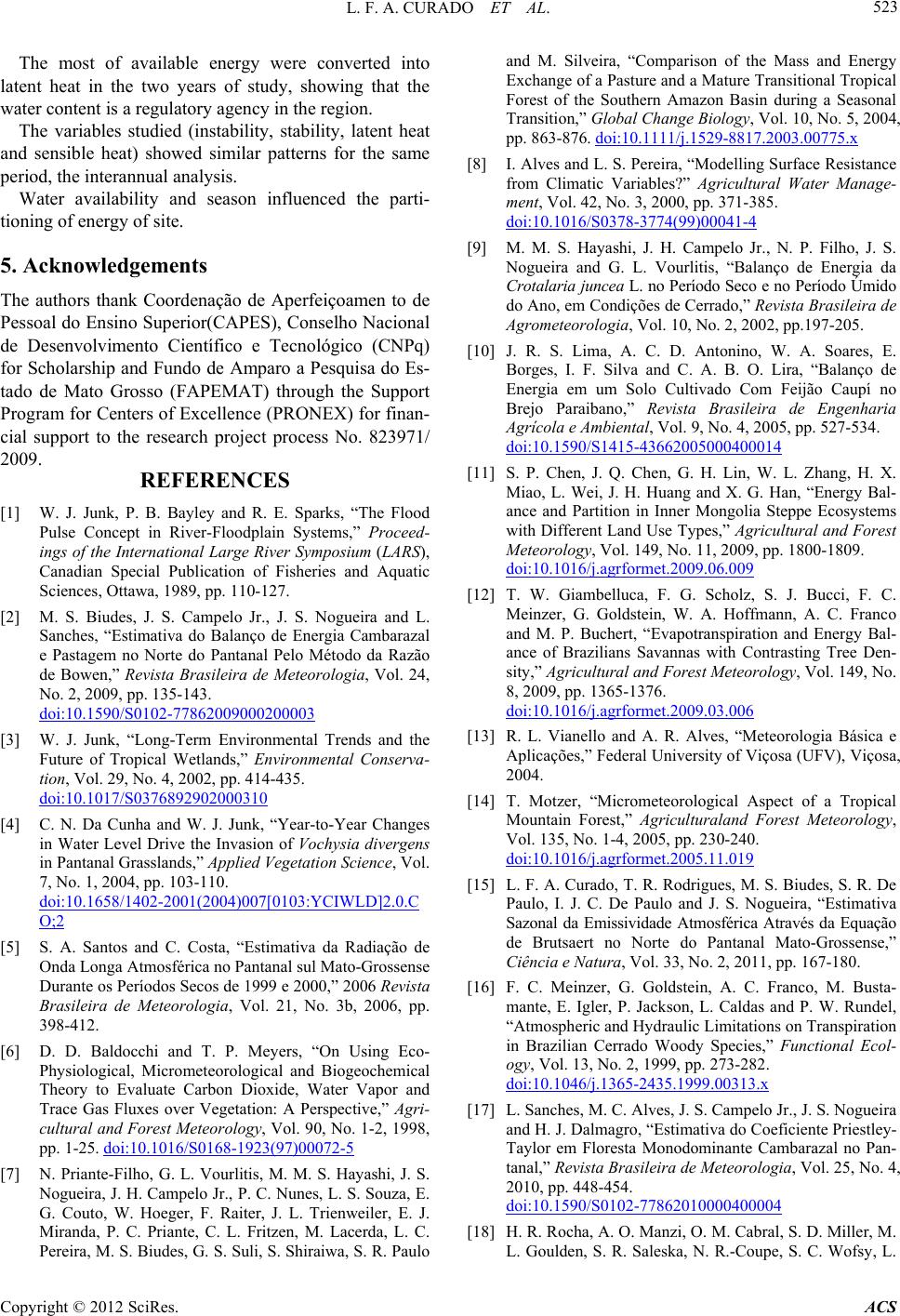
L. F. A. CURADO ET AL. 523
The most of available energy were converted into
latent heat in the two years of study, showing that the
water content is a regulatory agency in the region.
The variables studied (instability, stability, latent heat
and sensible heat) showed similar patterns for the same
pe
ntífico e Tecnológico (CNPq)
Amparo a Pesquisa do
MAT) through the Support
anadian Special Publication of Fisheries and Aquatic
Sciences, Otta
riod, the interannual analysis.
Water availability and season influenced the parti-
tioning of energy of site.
5. Acknowledgements
The authors thank Coordenação de Aperfeiçoamen to de
Pessoal do Ensino Superior(CAPES), Conselho Nacional
de Desenvolvimento Cie
for Scholarship and Fundo de
tado de Mato Grosso (FAPE
Es-
Program for Centers of Excellence (PRONEX) for finan-
cial support to the research project process No. 823971/
2009. REFERENCES
[1] W. J. Junk, P. B. Bayley and R. E. Sparks, “The Flood
Pulse Concept in River-Floodplain Systems,” Proceed-
ings of the International Large River Symposium (LARS),
C
wa, 1989, pp. 110-127.
[2] M. S. Biudes, J. S. Campelo Jr., J. S. Nogueira and L.
Sanches, “Estimativa do Balanço de Energia Cambarazal
e Pastagem no Norte do Pantanal Pelo Método da Razão
de Bowen,” Revista Brasileira de Meteorologia, Vol. 24,
No. 2, 2009, pp. 135-143.
doi:10.1590/S0102-77862009000200003
[3] W. J. Junk, “Long-Term Environmental Trends and the
Future of Tropical Wetlands,” Environmental Conserva-
tion, Vol. 29, No. 4, 2002, pp. 414-435.
doi:10.1017/S0376892902000310
[4] C. N. Da Cunha and W. J. Junk, “Year-to-Year Changes
YCIWLD]2.0.C
in Water Level Drive the Invasion of Vochysia divergens
in Pantanal Grasslands,” Applied Vegetation Science, Vol.
7, No. 1, 2004, pp. 103-110.
doi:10.1658/1402-2001(2004)007[0103:
O;2
[5] S. A. Santos and C. Costa, “Estimativa da Radiação de
Onda Longa Atmosférica no Pantanal sul Mato-Grossense
Durante os Períodos Secos de 1999 e 2000,” 2006 Revista
Brasileira de Meteorologia, Vol. 21, No. 3b, 2006, pp
398-412.
.
[6] D. D. Baldocchi and T. P. Meyers, “On Using Eco-
Physiological, Micrometeorological and Biogeochemical
Theory to Evaluate Carbon Dioxide, Water Vapor and
Trace Gas Fluxes over Vegetation: A Perspective,” Agri-
cultural and Forest Meteorology, Vol. 90, No. 1-2, 1998,
pp. 1-25. doi:10.1016/S0168-1923(97)00072-5
[7] N. Priante-Filho, G. L. Vourlitis, M. M. S. Hayashi, J. S.
Nogueira, J. H. Campelo Jr., P. C. Nunes, L. S. Souza, E.
G. Couto, W. Hoeger, F. Raiter, J. L. Trienweiler, E. J.
Miranda, P. C. Priante, C. L. Fritzen, M. Lacerda, L. C.
Pereira, M. S. Biudes, G. S. Suli, S. Shiraiwa, S. R. Paulo
and M. Silveira, “Comparison of the Mass and Energy
Exchange of a Pasture and a Mature Transitional Tropical
Forest of the Southern Amazon Basin during a Seasonal
Transition,” Global Change Biology, Vol. 10, No. 5, 2004,
pp. 863-876. doi:10.1111/j.1529-8817.2003.00775.x
[8] I. Alves and L. S. Pereira, “Modelling Surface Resistance
from Climatic Variables?” Agricultural Water Manage-
ment, Vol. 42, No. 3, 2000, pp. 371-385.
doi:10.1016/S0378-3774(99)00041-4
[9] M. M. S. Hayashi, J. H. Campelo Jr., N. P. Filho, J. S.
Nogueira and G. L. Vourlitis, “Balanço de Energia da
.197-205.
. A. Soares, E.
Crotalaria juncea L. no Período Seco e no Período Úmido
do Ano, em Condições de Cerrado,” Revista Brasileira de
Agrometeorologia, Vol. 10, No. 2, 2002, pp
[10] J. R. S. Lima, A. C. D. Antonino, W
Borges, I. F. Silva and C. A. B. O. Lira, “Balanço de
Energia em um Solo Cultivado Com Feijão Caupí no
Brejo Paraibano,” Revista Brasileira de Engenharia
Agrícola e Ambiental, Vol. 9, No. 4, 2005, pp. 527-534.
doi:10.1590/S1415-43662005000400014
[11] S. P. Chen, J. Q. Chen, G. H. Lin, W. L. Zhang, H. X.
Miao, L. Wei, J. H. Huang and X. G. Han, “Energy Bal-
ance and Partition in Inner Mongolia Steppe Ecosystems
with Different Land Use Types,” Agricultural and Forest
Meteorology, Vol. 149, No. 11, 2009, pp. 1800-1809.
doi:10.1016/j.agrformet.2009.06.009
[12] T. W. Giambelluca, F. G. Scholz, S. J. Bucci, F. C.
Meinzer, G. Goldstein, W. A. Hoffmann, A. C. Franco
and M. P. Buchert, “Evapotranspiration and Energy Bal-
ance of Brazilians Savannas with Contrasting Tree Den-
sity,” Agricultural and Forest Meteorology, Vol. 149, N
8, 2009, pp. 1365-1376.
o.
doi:10.1016/j.agrformet.2009.03.006
[13] R. L. Vianello and A. R. Alves, “Meteorologia Básica e
Aplicações,” Federal University of Viçosa (UFV), Viçosa,
2004.
[14] T. Motzer, “Micrometeorological Aspect of a Tropical
Mountain Forest,” Agriculturaland Forest M
Vol. 135, No. 1-4, 2005, pp. 230-240.
eteorology,
doi:10.1016/j.agrformet.2005.11.019
[15] L. F. A. Curado, T. R. Rodrigues, M. S. Biudes, S. R. De
Paulo, I. J. C. De Paulo and J. S. Nogueira, “Estimativa
pp. 167-180.
Franco, M. Busta-
Sazonal da Emissividade Atmosférica Através da Equação
de Brutsaert no Norte do Pantanal Mato-Grossense,”
Ciência e Natura, Vol. 33, No. 2, 2011,
[16] F. C. Meinzer, G. Goldstein, A. C.
mante, E. Igler, P. Jackson, L. Caldas and P. W. Rundel,
“Atmospheric and Hydraulic Limitations on Transpiration
in Brazilian Cerrado Woody Species,” Functional Ecol-
ogy, Vol. 13, No. 2, 1999, pp. 273-282.
doi:10.1046/j.1365-2435.1999.00313.x
[17] L. Sanches, M. C. Alves, J. S. Campelo Jr., J. S. Nogueira
and H. J. Dalmagro, “Estimativa do Coeficiente Priestley-
Taylor em Floresta Monodominante Cambarazal no Pan-
tanal,” Revista Brasileira de Meteorologia, Vol. 25, No. 4,
2010, pp. 448-454.
doi:10.1590/S0102-77862010000400004
[18] H. R. Rocha, A. O. Manzi, O. M. Cabral, S. D. Miller, M.
L. Goulden, S. R. Saleska, N. R.-Coupe, S. C. Wofsy, L.
Copyright © 2012 SciRes. ACS